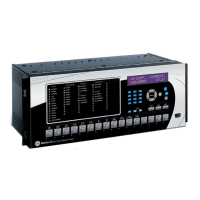GE Multilin L60 Line Phase Comparison System 8-35
8 THEORY OF OPERATION 8.2 SINGLE-POLE TRIPPING
8
The TRIP 1-POLE operand initiates automatically a single-pole autoreclose. The autoreclose is started and asserts the AR
RIP
operand. This operand keeps blocking the phase selector so that it does not respond to any subsequent events. At the
same time the operand removes zero-sequence directional supervision from ground distance zones 2 and 3 so that they
could respond to a single-line-to-ground fault during open pole conditions.
The AR FORCE 3-P TRIP operand is asserted 1.25 cycles following autoreclose initiation. This operand acts as an enabler
for any existing trip request. In this case none of the protection elements is picked up at this time, therefore no more trips
are initiated.
When the recloser dead time interval is complete it signals the breaker control element to close the breaker. The breaker
control element operates output relays to close the breaker.
When pole A of the breaker closes this new status is reported to the breaker control element, which transfers this data to
the breaker failure, autorecloser, open pole detector and trip output elements. The response at breaker failure is dependent
on the programming of that element. The response at the autorecloser is not relevant to this discussion. At the open pole
detector, the blocking signals to protection elements are de-asserted.
If the fault was transient the reset time would expire at the autorecloser and the
AR FORCE 3-P TRIP and RIP outputs would
be de-asserted, returning all features to the state described at the beginning of this description.
If the fault was permanent appropriate protection elements would detect it and place a trip request for the trip output ele-
ment. As the AR FORCE 3-P TRIP is still asserted, the request is executed as a three-pole trip.
The response of the system from this point is as described above for the second trip, except the autorecloser will go to lock-
out upon the next initiation (depending on the number of shots programmed).
c) SLG FAULT EVOLVING INTO LLG
When an AG fault occurs the events unfold initially as in the previous example. If the fault evolves quickly, the phase selec-
tor will change its initial assessment from AG to ABG fault and when the trip request is placed either by zone 1 or the line
phase comparison element (ANSI 87PC), a three-pole trip will be initiated. If this is the case, all three
TRIP PHASE A, TRIP
PHASE B
and TRIP PHASE C operands will be asserted. The command is passed to the breaker control element and results
in a three-pole trip. At the same time the recloser is initiated as per settings of the trip output. As the
TRIP 3-POLE operand
is asserted (not the TRIP 1-POLE operand) the open pole is not activated. Because the AR RIP in progress is asserted, the
phase selector is blocked as well.
If the fault evolves slowly, the sequence is different: The relay trips phase A as in the previous example. The phase selector
resets, the open pole detector is activated and forces the zone 1 and zone 2 AG, AB, CA and negative-sequence overcur-
rent elements to reset. If the zone 1 BG or line phase comparison element (ANSI 87PC) picks up, no trip command will be
issued until the
AR FORCE 3-P TRIP is asserted. This happens 1.25 cycles after the first trip. If at this time or any time later a
request for trip is placed (due to an evolving fault), a three-pole trip is initiated. The TRIP 1-POLE operand is de-asserted by
the
TRIP 3-POLE operand, resetting the open pole detector. Shortly all three-poles are opened.
When the dead time expires, the recloser signals the breaker control to close the breaker. At this time all the protection ele-
ments are operational, as the open pole detector is not blocking any elements. If the line-side VTs are used, the line pickup
element is armed as well. If there is a fault on the line, these elements will pickup the fault and issue next request for trip.
This request results in three-pole trip as the
AR FORCE 3-P TRIP is still asserted.
The response of the system from this point is as described above for the second trip, except the recloser will go to lockout
upon the next initiation (depending on the number of shots programmed).

